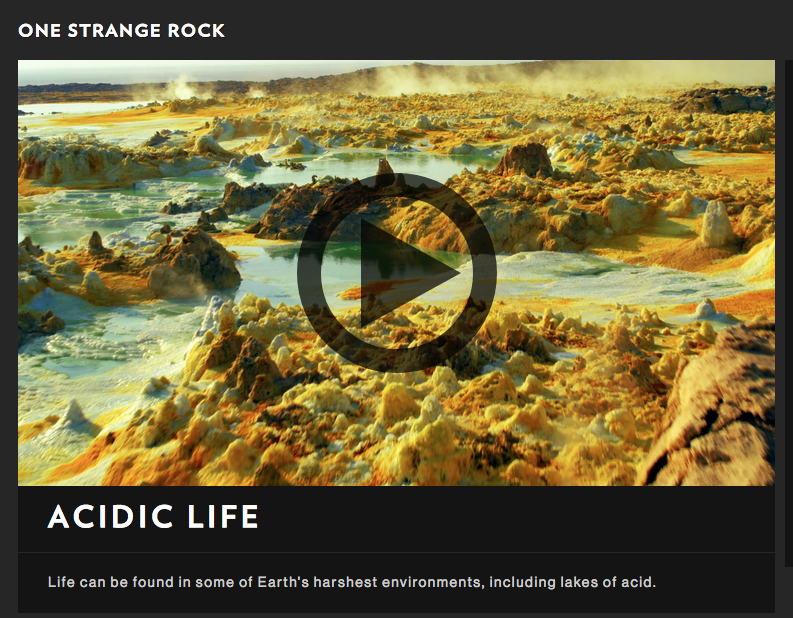Three billion years ago, Earth was a very different place.
-
Jim Bridenstine Sworn in as NASA Administrator
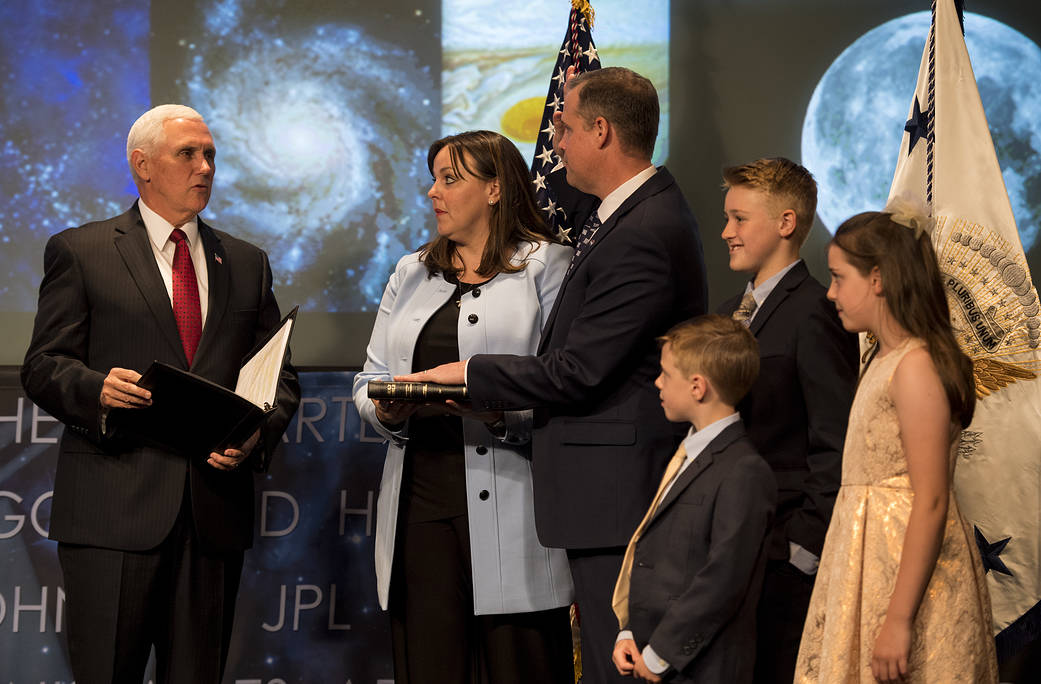
Jim Bridenstine, right, is sworn in as the 13th NASA Administrator by Vice President Mike Pence as Bridenstine's family watches, Monday, April 23, 2018 at NASA Headquarters in Washington. Source: Photo Credit: NASA/Joel KowskyJim Bridenstine was confirmed by the U.S. Senate on Thursday, April 19, 2018 to serve as the agency’s 13th administrator and sworn in by Vice President Mike Pence on April 23. Vice President Pence and newly sworn-in NASA Administrator Bridenstine spoke live with three NASA astronauts on the International Space Station.
Source: [NASA]
April 23, 2018 • Written by: NASA • Report issue
-
TESS Satellite Launched
Video Source: SciNewsThe Transiting Exoplanet Survey Satellite (TESS), aboard the SpaceX Falcon 9, successfully launched into space from Cape Canaveral Air Force Station, Florida on April 18, 2018.
TESS will spend two years surveying the sky, initially around 200,000 stars, monitoring for drops in brightness from transiting planets, to track down candidates for follow-up investigation. TESS PI George Ricker, Senior Research Scientist at MIT Kavli Institute, estimates that somewhere between 500 to 1,000 Earth-sized and super-Earth-sized exoplanets could be detected out of an overall excess of 20,000 exoplanets.
The information TESS provides could then be further analyzed by current instruments and future missions like the James Webb Space Telescope (JWST), to shed more light on the characteristics of the discovered planets. Eventually, combined with additional surveys from upcoming exoplanet missions, we will have a greater understanding of what lies beyond our solar system and how much of it is potentially habitable.
The Astrobiology Magazine Guide to TESS provides a detailed overview of the mission and its trajectory.
Further information on TESS and its relationship to astrobiology, along with links to TESS resources, is available at the Astrobiology at NASA website.
April 19, 2018 • Written by: Miki Huynh • Report issue
-
2028 ESA Space Mission Focuses on Nature of Exoplanets
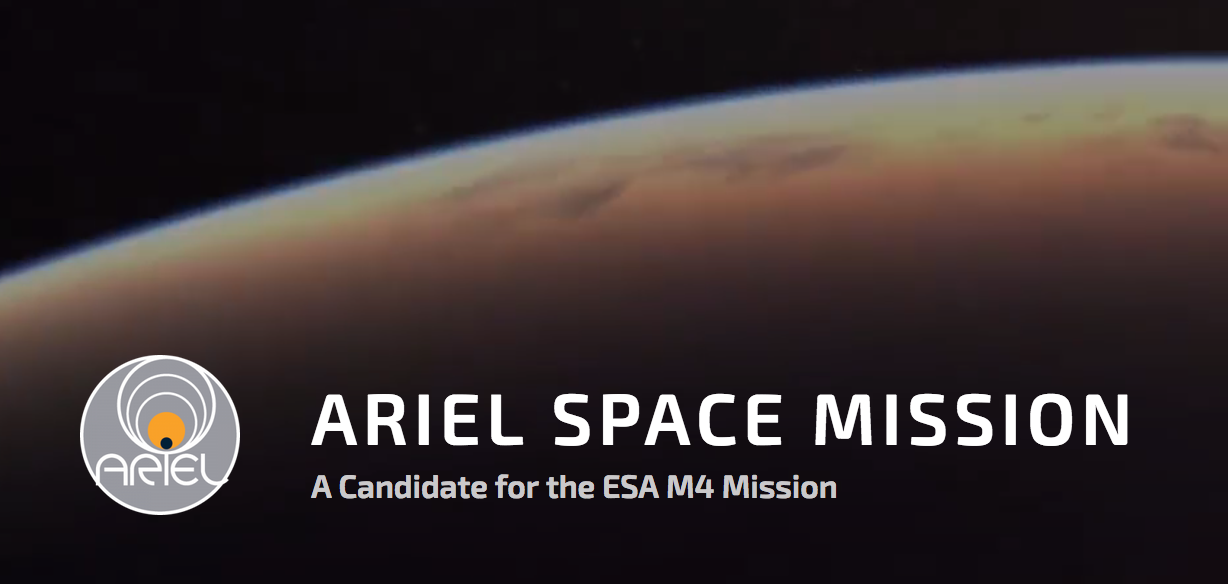
The ARIEL (Atmospheric Remote-sensing Exoplanet Large-survey) space mission has been selected by the European Space Agency (ESA) as the next medium-class science mission. Image source: ARIEL Space Mission / ESA.In March of 2018, ARIEL (Atmospheric Remote-sensing Exoplanet Large-survey), developed by a consortium of more than 50 institutes from 12 European countries, was selected as the European Space Agency’s next medium-class mission, the first dedicated to exoplanet atmospheres. The four-year mission, planned for launch in 2028, will observe 1000 planets orbiting distant stars and make the first large-scale survey of the chemistry of the atmospheres.
“ARIEL will study a statistically large sample of exoplanets to give us a truly representative picture of what these planets are like. This will enable us to answer questions about how the chemistry of a planet links to the environment in which it forms, and how its birth and evolution are affected by its parent star,” said Giovanna Tinetti, PI for the ARIEL mission and Professor of Astrophysics at University College London. She is also a former NASA Astrobiology Postdoctoral Fellow at JPL and a past member of the NASA Astrobiology Institute.
More information on ARIEL, including facts, figures, and press release, are available at the ARIEL Space Mission website.
Source: [ESA]
April 13, 2018 • Written by: Miki Huynh • Report issue
-
Dr. Jim Green Announced as New NASA Chief Scientist
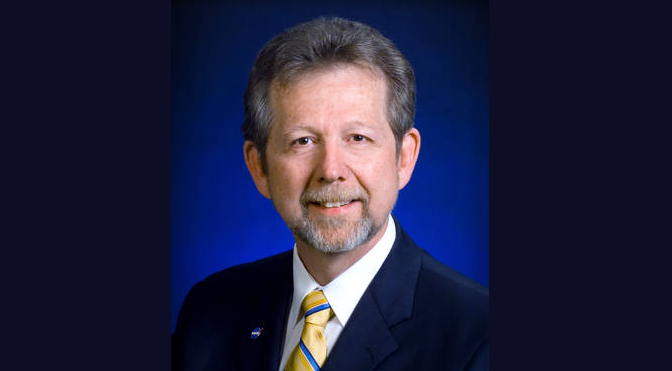
Dr. Jim Green will serve as NASA Chief Scientist beginning May 1, 2018. Credit: NASAActing NASA Administrator Robert Lightfoot has named the Science Mission Directorate’s Planetary Science Division Director Jim Green as the agency’s new chief scientist, effective May 1. He succeeds Gale Allen, who has served in an acting capacity since 2016 and will retire after more than 30 years of government service.
Source: [NASA]
April 10, 2018 • Written by: NASA • Report issue
-
Emergence of Life in a Radically Different Environment

An icy lake in Svalbard, Norway, taken by an unmanned aerial vehicle. Life on Earth may have begun in an environment with both water and ice, and modern analogs may help the scientific community understand how. Image credit: Marjorie D. Cantine. (via Astrobiology Magazine)Marjorie Cantine, graduate student with the Earth, Atmospheric and Planetary Sciences department at MIT, and Greg Fournier, professor of Geobiology at MIT and a member of the Foundations of Complex Life team of the NASA Astrobiology Institute, have co-authored a paper tracing possible evidence for the beginnings of life under very different environmental conditions than those currently assumed for the last universal common ancestor (LUCA). Cantine and Fournier suggest how that separate evolution might shift our thinking about LUCA and provide a different take on how we assume life emerged within extreme environments such as Mars.
A feature story is available at Astrobiology Magazine.
“Environmental Adaptation from the Origin of Life to the Last Universal Common Ancestor” is published in Origins of Life and Evolution of Biospheres.
Source: [Astrobiology Magazine]
April 09, 2018 • Written by: Miki Huynh • Report issue
-
NASA Prepares to Launch Next Mission to Search Sky for New Worlds

Illustration of the Transiting Exoplanet Survey Satellite (TESS) in front of a lava planet orbiting its host star. TESS will identify thousands of potential new planets for further study and observation. Source: NASA/GSFCNASA’s Transiting Exoplanet Survey Satellite (TESS) is undergoing final preparations in Florida for its April 16 launch to find undiscovered worlds around nearby stars, providing targets where future studies will assess their capacity to harbor life.
“One of the biggest questions in exoplanet exploration is: If an astronomer finds a planet in a star’s habitable zone, will it be interesting from a biologist’s point of view?” said George Ricker, TESS principal investigator at the Massachusetts Institute of Technology (MIT) Kavli Institute for Astrophysics and Space Research in Cambridge, which is leading the mission. “We expect TESS will discover a number of planets whose atmospheric compositions, which hold potential clues to the presence of life, could be precisely measured by future observers.”
Source: [NASA]
April 03, 2018 • Written by: NASA • Report issue
-
Early Career Scholarships for Field Trip to Key Astrobiology Sites of Australia

Image Source: ACAApplication Deadline: Wednesday, April 13, 2018 at 9PM PST
The NASA Astrobiology Institute is accepting applications from early career PhD astrobiologists (within 3 years of their degree) to participate in a 10-day trip to astrobiology-relevant field sites in Western Australia. Included will be remote sites of fossilized stromatolites from the c. 1.8 Ga Duck Creek Dolomite and c. 2.4 Ga Turee Creek Group, and a walk through the transition across the rise of atmospheric oxygen (the GOE). We will then camp at Karijini National Park and hike through a canyon with walls made of 2.5 Ga Banded Iron Formation (BIF), and swim at the beautiful Fortescue Falls. Following this, will be a visit to stromatolites of the c. 2.7 Ga Fortescue Group, then the c. 3.35-3.49 Ga fossiliferous units of hte Pilbara Craton, including newly discovered geyserite in the Dresser Formation, site of the oldest evidence for life on land.
The expedition, from July 2 to July 11, 2018, will be led by Professor Martin Van Kranendonk of the University of New South Wales, the director of the Australian Centre for Astrobiology (ACA). The trip is designed for scientists interested in the earliest life on Earth and early Earth environments.
March 30, 2018 • Posted by: Miki Huynh • Report issue
-
"In Her Orbit" Highlights Life and Work of Nathalie Cabrol

Nathalie Cabrol. Credit: SETINathalie Cabrol, Senior Research Scientist and Director of the Carl Sagan Center at SETI and PI for the SETI team of the NASA Astrobiology Institute, is featured in an in-depth New York Times Magazine story by Helen Macdonald, who traveled with Cabrol and her team in 2016 to the high-altitude regions of Chile as they conducted Mars-related research in the fascinating and harsh environments.
Macdonald connects the journey with details from Cabrol’s life, unearthing a poignant and human side to the scientist and science of searching for life in the Universe.
Read the full story, “In Her Orbit.”
____
Related Story: The Search for Mars Biosignatures Up at High Altitudes
Source: [New York Times Magazine]
March 28, 2018 • Written by: Miki Huynh • Report issue
-
One Strange Rock
Research conducted by astrobiologists from the Planetary Habitability Laboratory (PHL) and the Arecibo Observatory will be highlighted in the upcoming National Geographic series, One Strange Rock. The series presents a “mind-bending, thrilling journey that explores the fragility and wonder of planet Earth” and premieres March 26, 2018.
A press release highlighting the early premiere of One Strange Rock at PHL is available at their website. PHL Director Prof. Abel Mendez was a 2007 Minority Institution Research Support (MIRS) Program—now the Astrobiology Faculty Diversity (AFD) Program—fellow.
Video clips of One Strange Rock, including one featuring past NAI team member Dr. Felipe Gomez Gomez of the Centro de Astrobiologia (CAB), are available through National Geographic.
Source: [National Geographic]
March 23, 2018 • Written by: Miki Huynh • Report issue
-
Could Shallow Biospheres Exist Beneath the Icy Ceilings of Ocean Moons?

Vent tubeworms, such as Riftia pachyptila found near the Galapagos Islands, represent the kinds of life that can persist near deep sea hydrothermal vents, the source of chemical energy that may provide one of the building blocks for life. Credit: NOAA Okeanos Explorer Program, Galapagos Rift Expedition 2011 (via Astrobiology Magazine)Astrobiologist Michael Russell, Co-I of the NASA Astrobiology Institute Icy World’s Team at NASA’s Jet Propulsion Laboratory, and his colleagues suggest that where an icy crust and a hidden ocean meet in a frozen world such as Europa, two sources of the building blocks of life could join together and potentially support the evolution of life. At the underside of Europa’s icy crust, they suggest that a shallow biosphere–a network of ecosystems–can form.
The feature story by Charles Q. Choi is published in Astrobiology Magazine.
____The research paper, “The Possible Emergence of Life and Differentiation of a Shallow Biosphere on Irradiated Icy Worlds: The Example of Europa” is published in Astrobiology.
Source: [Astrobiology Magazine (astrobio.net)]
March 14, 2018 • Posted by: Miki Huynh • Report issue
-
New Clues to Compositions of TRAPPIST-1 Planets

This artist's concept shows what the TRAPPIST-1 planetary system may look like, based on available data about the planets' diameters, masses and distances from the host star, as of February 2018. Credits: NASA/JPL-CaltechThe seven Earth-size planets of TRAPPIST-1 are all mostly made of rock, with some having the potential to hold more water than Earth, according to a new study published in the journal Astronomy and Astrophysic. The planets’ densities, now known much more precisely than before, suggest that some planets could have up to 5 percent of their mass in water — which is 250 times more than the oceans on Earth.
Source: [NASA JPL]
March 06, 2018 • Written by: NASA JPL • Report issue
-
Does Titan's Hydrocarbon Soup Hold a Recipe for Life?

This image shows Titan in ultraviolet and infrared wavelengths. Red and green colors indicate where atmospheric methane is absorbing light, while the blue color shows the upper atmospheric haze. Image credit: NASA/JPL/Space Science InstituteNASA researchers have confirmed the existence in Titan’s atmosphere of vinyl cyanide, which is an organic compound that could potentially provide the cellular membranes for microbial life to form in Titan’s vast methane oceans. If true, it could prove to us that life can flourish without the ubiquitous HO.
The full story is available at Astrobiology Magazine.
____
The Goddard Center for Astrobiology’s research paper, “ALMA detection and astrobiological potential of vinyl cyanide on Titan” is published in Science Advances.
Source: [Astrobiology Magazine (astrobio.net)]
March 02, 2018 • Written by: Lisa Kaspin-Powell • Report issue
-
Noah Planavsky Selected for the 2018 F. W. Clarke Award

Noah Planavsky of the Alternative Earths Team of the NASA Astrobiology Institute will receive the 2018 F. W. Clarke Medal. Image source: YaleNoah Planavsky, Assistant Professor of Geology and Geophysics at Yale University and a member of the NASA Astrobiology Institute teams based at UC Riverside, MIT, and the Virtual Planetary Laboratory, will be receiving the F. W. Clarke Medal this August at the 2018 Goldschmidt Conference.The medal is awarded each to year to an early-career scientist in recognition for an outstanding contribution to geochemistry or cosmochemistry, published as a paper or series of papers.
Planavsky is recognized for his work on mid-Proterozoic oxygen levels, as defined by his novel application of the chromium (Cr) isotope proxy.
His previous honors include the 2016 Packard Fellowship for Science and Engineering and the 2016 Alfred P. Sloan Fellowship in Ocean Sciences. He was selected in 2008 for the Lewis and Clark Fund, with results from his field research later published in Nature and PNAS. Planavsky is a PI for the NASA Exobiology and Evolutionary Biology program and an advisor for the NASA Astrobiology Postdoctoral Program.
More information about Noah Planavsky’s work with the Yale Metal Geochemistry Center can be found at their website.
More information on the F. W. Clarke Award is available through the Geochemical Society.
___
Related Story: Noah Planavsky Selected as a 2016 Alfred P. Sloan Fellow in Ocean Sciences
Source: [Geochemical Society]
March 01, 2018 • Posted by: Miki Huynh • Report issue
-
Signs of Warmth in Mars' Past
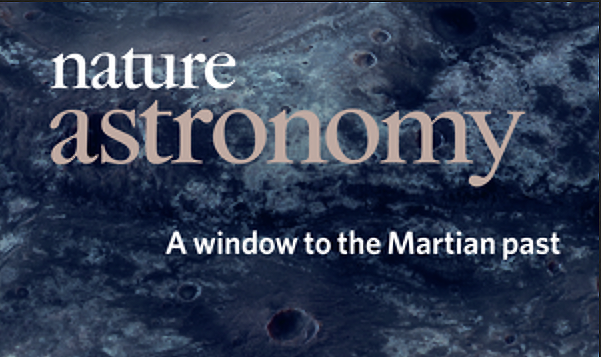
A new climate model suggests that short-term periods of warm environments during Mars cold past may explain the present day surface mineralogy of Mars. Source: Christoph Gross / Bethany Vukomanovic / Nature Astronomy
Janice Bishop, Senior Research Scientist at the SETI Institute and member of the Changing Planetary Environments and Fingerprints of Life Team of the NASA Astrobiology Institute, has developed a new climate model for Mars that may explain how surface clay minerals at regions such as Mawrth Vallis formed— rocks that would be geochemically created by an early presence of warm, liquid water.
While previous climate models could not account for such formations, the SETI Institute team’s new model suggests that the cold early climate of Mars may have been interrupted by sporadic short-term bursts of warmer, wetter environments to create these surface clays.
The research is published in Nature Astronomy, and is featured on the cover of the March 2018 issue. The paper can also be viewed as an E-print.
A science news story is available at the SETI Institute.
Source: [Nature Astronomy (via SETI Institute)]
February 27, 2018 • Written by: Miki Huynh • Report issue
-
Release of Annual Research Opportunities in Space and Earth Sciences 2018 (ROSES–2018) Omnibus NASA Research Announcement (NRA)

NASA's Science Mission Directorate (SMD) announces the release of its annual omnibus solicitation for basic and applied research, Research Opportunities in Space and Earth Science (ROSES) 2018. Image source: NASA AstrobiologyNASA’s Science Mission Directorate (SMD) has announced the release of its annual omnibus solicitation for basic and applied research, Research Opportunities in Space and Earth Science (ROSES) 2018 at http://solicitation.nasaprs.com/ROSES2018.
ROSES is an omnibus solicitation, with many individual program elements, each with its own due dates and topics. Table 2 and Table 3 of the NASA Research Announcement (NRA) provide proposal due dates and hyperlinks to descriptions of the solicited program elements in the Appendices of this NRA.
Source: [NASA Science Mission Directorate]
February 20, 2018 • Posted by: Miki Huynh • Report issue




